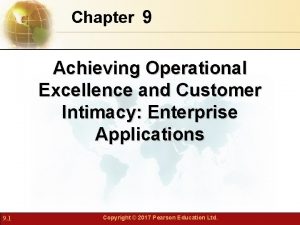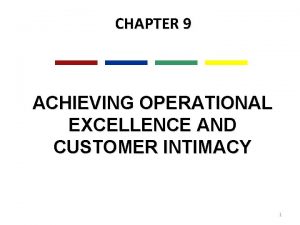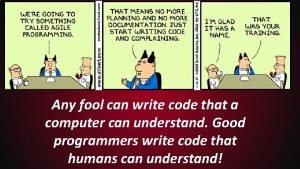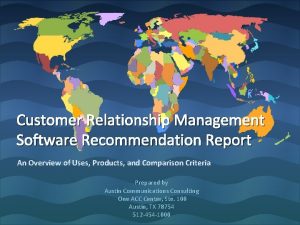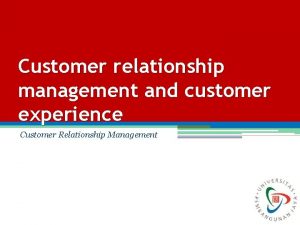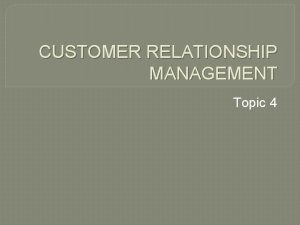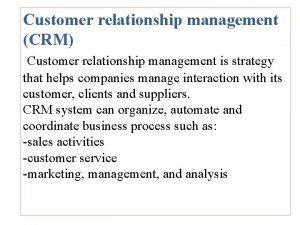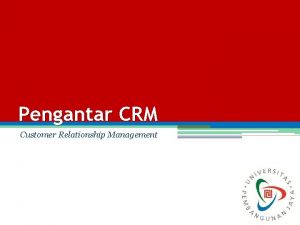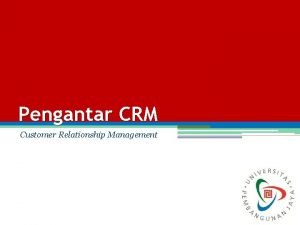Customer Relationship Management Helps understand How can companies









- Slides: 9

Customer Relationship Management

Helps understand: �How can companies deliver customer value, satisfaction, and loyalty? �What is the lifetime value of a customer, and why is it important to marketers? �How can companies cultivate strong customer relationships? �What is the role of database marketing in customer relationship management?

Value, Loyalty, Satisfaction � Customer perceived value (CPV)—the difference between the prospective customer’s evaluation of all the benefits and all the costs of an offering and the perceived alternatives. � Loyalty A deeply held commitment to re‐buy or re‐patronize a preferred product or service in the future despite situational influences and marketing efforts having the potential to cause switching behavior. � Satisfaction A person’s feelings of pleasure or disappointment that result from comparing a product’s perceived performance (or outcome) to expectations.

Profitable customers �Customer Lifetime Value (CLV) Describes the net present value of the stream of future profits expected over the customer’s lifetime purchases. �Customer relationship management (CRM) is the process of carefully managing detailed information about individual customers and all customer “touch points” to maximize customer loyalty. Touch point—any occasion on which a customer encounters the brand product.

Customer Database and Database Marketing �Customer database—an organized collection of comprehensive information about individual customers or prospects that is current, accessible, and actionable for marketing purposes. �Database marketing—the process of building, maintaining, and using customer databases and other databases to make contact, facilitate transactions, and build customer relationships.

Data Warehouse and Datamining �Data warehouse—organized data where marketers can capture, query, and analyze it to draw inferences about an individual customer’s needs and responses. �Datamining—statisticians extract useful information about individuals, trends, and segments from the mass of data.

Database Uses �Identify the best prospects � Match a specific offer with a specific customer as a way to sell, cross‐sell, and up‐sell �Deepen customer loyalty by remembering preferences and offering relevant incentives and information �Reactivate customer purchasing �Avoid serious mistakes

Downside of Database Marketing and CRM �Large investment �Difficulty in getting everyone to be customer oriented �Not all customers want an ongoing relationship �Assumptions behind CRM may not always hold true

Tesco • Top 100 customers were worth as much as bottom 4000 • bottom 25% customers represented only 2% of sales • Top 5% customers were responsible for 20% of sales • Introduced the Clubcard: Dismissed by competitors! • vouchers for frequently bought items • Offered to explore parts of store that they did not visit recently • Different lifestyles magazines created for different customers • High value customers had personal shoppers, valet parking etc • Added student club card and mothers club card • By the end of 3 rd year they identified 108 customer segments
 Customer relationship management and customer intimacy
Customer relationship management and customer intimacy Customer relationship management and customer intimacy
Customer relationship management and customer intimacy Intimacy
Intimacy History contributes to moral understanding.
History contributes to moral understanding. Factoring is important process
Factoring is important process To understand recursion you must understand recursion
To understand recursion you must understand recursion E crm
E crm Any fool can write code that a computer can understand
Any fool can write code that a computer can understand Leader development marines
Leader development marines Recommendation for customer relationship management
Recommendation for customer relationship management

